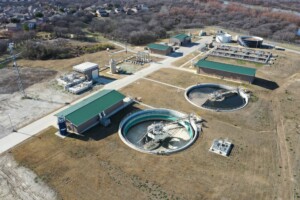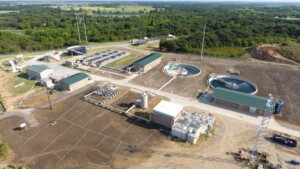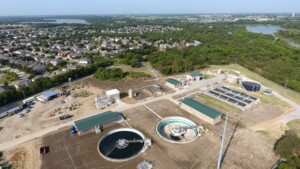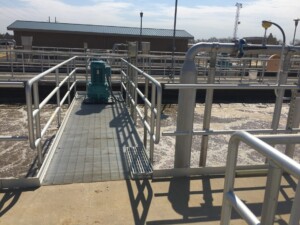Challenge
Upper Trinity Regional Water District’s (UTRWD) Riverbend Water Reclamation Plant (WRP), located in north central Texas near the city of Aubrey, needed to increase its capacity from 2 million gallons per day (mgd) annual average daily flow to 4 mgd with a peak flow rate of 16 mgd. Carollo evaluated the existing capacity of the plant and planned the facility expansions through 2040. Carollo recommended an immediate expansion to 4 mgd to keep up with the economic growth occurring to the north of the Dallas-Fort Worth metroplex. In order to increase capacity, a new influent pump station, new screening and grit removal headworks, a new sludge pump station building, modification of sequential batch reactor basins to conventional aeration basins with ballasted activated sludge, and new secondary clarifiers were required.
Several project drivers would make conventional project delivery of UTRWD’s Riverbend WRP capacity upgrade difficult to achieve. These drivers included the need to accelerate the schedule for the project, ensure that the scope of work was in alignment with the defined budget, and obtain the treatment equipment via a value-based selection process. Given these drivers, UTRWD determined that the construction management at-risk (CMAR) delivery method was the best approach for their project. UTRWD selected Archer Western Construction as their CMAR.
Approach
Schedule Acceleration
A typical design-bid-build project often requires two to three months for advertisement, assessment of bids, and award by council or board. In contrast, using CMAR enabled UTRWD to secure a guaranteed maximum price (GMP) during the design phase allowing for acceleration of the project schedule. For the Riverbend Expansion project, UTRWD and Archer Western agreed to a GMP contract at 90% design. This agreement allowed Archer Western to bid out the work during final design, have all subcontractors and equipment contracted before they were given notice to proceed, and then begin construction at full speed immediately upon completion of construction documents. Construction began within 12 months of project kickoff. UTRWD preferred to avoid any early-out packages or concurrent design and construction for this project. Even without using these options to accelerate the project, the CMAR delivery method reduced the overall project schedule by three months.
Scope and Budget Certainty
Like most projects, UTRWD had a set budget available for the expansion of the Riverbend WRP. Archer Western’s CMAR cost model allowed UTRWD to match the scope of the construction with its available budget. As an example, at 30% design, the cost model was $6 million over the $31 million budget. However, by collaborating with UTRWD and applying value analysis to align the project construction cost, the project budget was maintained at $31 million. Design changes resulting from the value engineering efforts included use of on-site soil, reducing the generator size by better defining essential equipment, and combining the RAS/ WAS building with the magnetite feed facility, which reduced pipe and conduit length and expense. In order for UTRWD to track and control the budget, the CMAR cost model was updated at each major design milestone. The project allowed UTRWD to reduce future capital investment by utilizing the BioMag® innovative process, and Carollo’s cost-effective design and reliable engineering services during construction exceeded the client’s expectations.
Innovative Solutions
One of the project objectives was to improve operations by converting existing sequencing batch reactors (SBR) to flow-through activated sludge. Inflow and infiltration into the collection system during extreme rain events created challenges in plant operations. For a conventional activated sludge plant with excess capacity, staff could monitor and adjust the aeration basins’ operation with dissolved oxygen probe measurements a few times a day. However, because the Riverbend WRP was
an SBR plant without excess capacity, plant staff had to collect multiple samples and run laboratory tests to optimize the fill, aerated reaction, anaerobic reaction, settling, and withdraw stage times. Additionally, plant operators had to continuously make adjustments based on multiple sample tests to determine the optimum SBR cycle times and sequences to produce high-quality effluent. Although these modifications allowed the plant to keep up with flow increases, UTRWD staff recognized the need to improve the plant’s treatment approach to make operations and maintenance easier to manage. Carollo designed the conversion from the SBR plant to activated sludge with plug flow aeration basins and clarifiers and increased the average daily flow capacity from 2 mgd to 4 mgd within the existing three basins. This conversion made the treatment process more reliable, offering a greater protection for the environment. In addition, the BioMag® process was utilized which eliminated the need for additional aeration basin structures which improved the performance of the plant.
Value-Based Selection of Equipment
Archer Western and UTRWD developed a value-based scoring system for assessing equipment which accounted for familiarity with the manufacturer representative, length of time in business, delivery time, location of service center and installation references, and ability to meet terms and conditions of the contract. Each piece of equipment was reviewed and the final equipment selection was based on best value, not simply the lowest price. The scoring system allowed UTRWD to get best value within their available budget. All equipment was bid and selected before the GMP, which allowed UTRWD to reduce the contingency included in the GMP.
Results
Employing the CMAR method delivered a successful Riverbend WRP Expansion project that was constructed faster than a typical design-bid-build project. It was delivered on time within the available budget. UTRWD maintained control of vendor and subcontractor selection to obtain needed materials, equipment, and workmanship that met their preferences and value expectations.
Carollo’s design incorporated BioMag® which is a ballasted activated sludge technology that reduces the aeration basin volume requirements and improves the secondary effluent quality by enhancing the settling performance. This technology resulted in construction cost savings through build-out totaling $4.5 million. Being the first installation in Texas, the project included a full-scale demonstration study and close coordination with the Texas Commission on Environmental Quality to obtain approval for BioMag®.
UTRWD took its community into consideration with this expansion, as the plant sits on the opposite side of a neighborhood fence. By scheduling concrete and equipment deliveries outside of “school zone” hours, the project team ensured that schoolchildren could safely cross the entrance to the plant. Additionally, the structure closest to the neighborhood was the operations building. This was designed to resemble one of the single-family homes across the fence to ease any potential eyesore. The headworks was equipped with odor control facilities to prevent odors from exiting the plant site and disturbing the neighbors.





